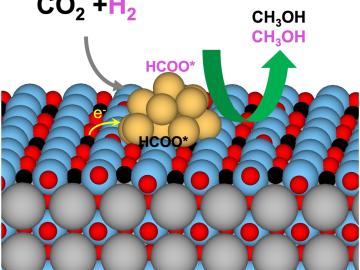Filter News
Area of Research
News Type
Date
News Topics
- 3-D Printing/Advanced Manufacturing (1)
- Artificial Intelligence (5)
- Big Data (3)
- Bioenergy (2)
- Biology (2)
- Biomedical (2)
- Biotechnology (1)
- Buildings (2)
- Chemical Sciences (5)
- Climate Change (3)
- Composites (1)
- Computer Science (5)
- Critical Materials (2)
- Decarbonization (4)
- Energy Storage (2)
- Environment (4)
- Fusion (1)
- Grid (1)
- High-Performance Computing (3)
- Isotopes (2)
- Machine Learning (1)
- Materials (3)
- Materials Science (1)
- National Security (2)
- Net Zero (1)
- Neutron Science (1)
- Partnerships (3)
- Physics (1)
- Polymers (1)
- Quantum Computing (1)
- Simulation (1)
- Statistics (2)
- Sustainable Energy (2)
- Transportation (3)
Media Contacts

Farragut High School graduate Channing Tan has been named recipient of the 2024 UT-Battelle Scholarship to attend the University of Tennessee.

Researchers at ORNL have successfully demonstrated the first 270-kW wireless power transfer to a light-duty electric vehicle. The demonstration used a Porsche Taycan and was conducted in collaboration with Volkswagen Group of America using the ORNL-developed polyphase wireless charging system.

Six firms received Small Business Awards from the Department of Energy’s Oak Ridge National Laboratory. The companies, selected from small business service providers to the lab, were recognized by ORNL's Small Business Programs Office for their specific capabilities and contributions.

Building innovations from ORNL will be on display in Washington, D.C. on the National Mall June 7 to June 9, 2024, during the U.S. Department of Housing and Urban Development’s Innovation Housing Showcase. For the first time, ORNL’s real-time building evaluator was demonstrated outside of a laboratory setting and deployed for building construction.

Vanderbilt University and ORNL announced a partnership to develop training, testing and evaluation methods that will accelerate the Department of Defense’s adoption of AI-based systems in operational environments.

Scientists have uncovered the properties of a rare earth element that was first discovered 80 years ago at the very same laboratory, opening a new pathway for the exploration of elements critical in modern technology, from medicine to space travel.

A team of scientists led by ORNL found an unconventional way to improve catalysts made of more than one material. The solution demonstrates a path to designing catalysts with greater activity, selectivity and stability.

Researchers at ORNL are developing battery technologies to fight climate change in two ways, by expanding the use of renewable energy and capturing airborne carbon dioxide.

ORNL researchers have produced the most comprehensive power outage dataset ever compiled for the United States. This dataset, showing electricity outages from 2014-22 in the 50 U.S. states, Washington D.C. and Puerto Rico, details outages at 15-minute intervals for up to 92% of customers for the eight-year period.

Scientists at ORNL completed a study of how well vegetation survived extreme heat events in both urban and rural communities across the country in recent years. The analysis informs pathways for climate mitigation, including ways to reduce the effect of urban heat islands.




